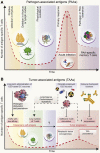Molecular and Translational Classifications of DAMPs in Immunogenic Cell Death
- PMID: 26635802
- PMCID: PMC4653610
- DOI: 10.3389/fimmu.2015.00588
Molecular and Translational Classifications of DAMPs in Immunogenic Cell Death
Abstract
The immunogenicity of malignant cells has recently been acknowledged as a critical determinant of efficacy in cancer therapy. Thus, besides developing direct immunostimulatory regimens, including dendritic cell-based vaccines, checkpoint-blocking therapies, and adoptive T-cell transfer, researchers have started to focus on the overall immunobiology of neoplastic cells. It is now clear that cancer cells can succumb to some anticancer therapies by undergoing a peculiar form of cell death that is characterized by an increased immunogenic potential, owing to the emission of the so-called "damage-associated molecular patterns" (DAMPs). The emission of DAMPs and other immunostimulatory factors by cells succumbing to immunogenic cell death (ICD) favors the establishment of a productive interface with the immune system. This results in the elicitation of tumor-targeting immune responses associated with the elimination of residual, treatment-resistant cancer cells, as well as with the establishment of immunological memory. Although ICD has been characterized with increased precision since its discovery, several questions remain to be addressed. Here, we summarize and tabulate the main molecular, immunological, preclinical, and clinical aspects of ICD, in an attempt to capture the essence of this phenomenon, and identify future challenges for this rapidly expanding field of investigation.
Keywords: anti-tumor immunity; immunogenicity; immunotherapy; molecular medicine; oncoimmunology; patient prognosis; translational medicine.
Figures



